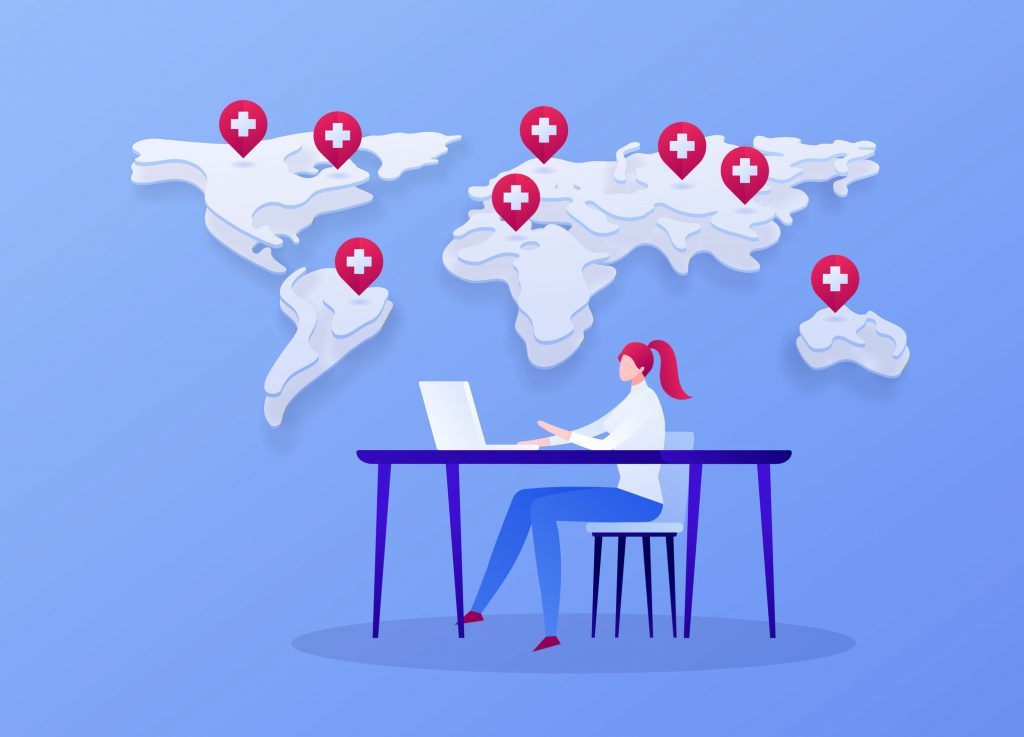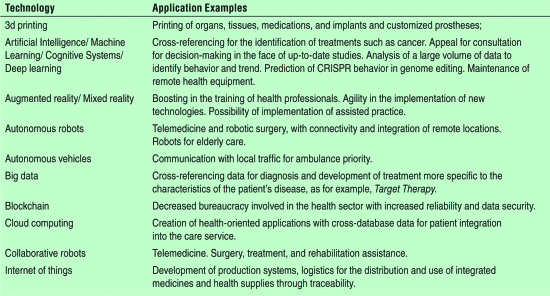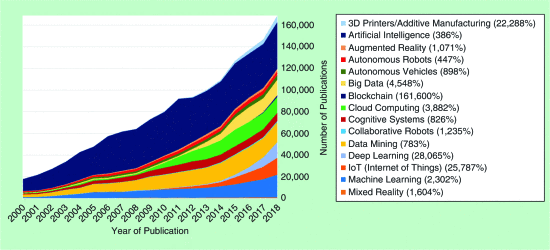 iStock/Anastasia Usenko
iStock/Anastasia Usenko Modern increases in computers’ capacity to store and process data have made possible the emergence and advancement of countless technologies that directly impact the daily lives of the world’s population. Although discussion of some of the most powerful new technologies began in the last century, only recently has their development generated large paradigm shifts. Important examples include artificial intelligence, data mining, and machine learning, among others. These technologies have then become responsible for the so-called Fourth Industrial Revolution (or Industry 4.0), where there is convergence between the digital, physical, and biological environment.
Healthcare is one of the sectors with the highest expectations for positive impacts of the 4.0 revolution.
The concept of Health 4.0 addresses the broad possibility of applying the technologies of Industry 4.0 to improve healthcare (as shown in Table 1; cf. Democracy 4.0 [1]). In this commentary we address the challenges and perspectives of Health 4.0 and how the risk of lack of control can delay its emergence (see also [2]).
Table 1.
Major Technologies in Accelerated Development and Their Potential Applications in Healthcare
In recent years, research on disruptive technologies in Industry 4.0 has increased exponentially in several fields, both in industrial and academic settings. The number of peer-reviewed articles on key technologies has increased about 949% over the past 19 years, when analyzed all together (p = 0.0007). Interestingly, there was an exponential increase in technologies such as Blockchain (161 600%), Deep learning (28 065%), and Internet of Things (25 787%) (Figure 1).
Figure 1. Scientific publications over the last 19 years (2000–2018) related to technologies that integrate the Fourth Industrial Revolution. The increase in the number of publications of each technology in the period is shown in the graph between parenthesis. The data were obtained from bibliographical searches in Engineering Village from 2000 to 2018 using general descriptors corresponding to each technology. Different technologies may have been combined in the same publication (e.g. in Big Data produced by Internet of Things); however, for the sake of global tendency, they were counted separately. The data were analyzed using paired t tests (α = 0.05).
This entire advance in technology, which consequently brings along a significant increase in productivity, is directly affecting the number and nature of jobs. There are divergences between the predictions of the impacts that the emergence of these new technologies will have on employment. Predictions range from a 9% [3] to 47% [4] reduction in current jobs due to automation.
However, in contrast to these forecasts, employment in the health sector has increased in recent years, reaching record levels in 2017 in the United States [5]. This increase in employment in health-related fields reinforces the idea that we cannot accurately predict the impacts that technological innovations will have on our lives.
Healthcare is one of the sectors with the highest expectations for positive impacts of the 4.0 revolution. For decades, the world population has grown exponentially, a fact that has been associated with advances in medicine, better health in aging populations, and longer life expectancies. However, this trend has also posed demands on healthcare systems, which must deal with the challenge of providing care without raising costs, given the fiscal constraints of the governments that provide such services to the population.
Challenges for Connected Health
In the annual risk survey of the World Economic Forum of 2017 [6], the management of technological disruption is identified as the third biggest challenge in the world for the next few years, exceeded only by risks related to the economy (with population growth and the need for reforms), and society (with the reconstruction of communities). The 2017 study points out that Industry 4.0, despite innumerable benefits, can generate new problems and exacerbate existing risks. In addition, when the issue at hand is connectivity, and therefore the exchange and sharing of information, security is the biggest concern. This was consolidated in the survey of the following year. The 2018 World Economic Forum report points to Cyberattacks and fraud/data theft as two of the top five risks [7].
In this sense, ensuring the emergence of Health 4.0 will depend on how norms and standards will be defined. Currently, as technology develops very rapidly, regulation does not follow the same pace. Some regulated sectors are hampered by the slowness of getting authorization to test technologies, which often only comes when they are already obsolete. This happened to Amazon, which took 8 months to get permission to test its drones in the United States.
The health sector is one of the most regulated and bureaucratic, especially when compared, for example, to robotics in manufacturing. Despite delays that this can generate for technologies to leave the test environment and reach the population, for safety it is prudent that such health developments are duly regulated and controlled. The connection and interoperability between chain links puts patient information at stake, and the fact that “medical things” are becoming more connected may increase the impact of cyber-attacks. Considering this, Health 4.0 should guarantee the safety of data, sector, and patients. Likewise, it should encourage the creation of patient-centered healthcare, with the possibility of interconnecting a global health technology system through open systems and the use of common standards, resulting in technological advances with paradigm shifts. This change should avoid what Thuemmler and Bai [8] called “Patchwork Progress,” where innovation and evolution occur only in parts of the industry, with heterogeneity of closed technologies, without interoperability, without exchange or sharing of data, with ample competition for domain market, and as a focus on the recovery of investments.
Health 4.0 Remains Unconnected
Health 4.0 proposes a more connected health system where, for instance, with the use of the Internet of Things (IoT) even a hospital bed may be connected to the network, thereby providing and making use of data. However, a large part of the world population unfortunately still does not have access to such innovative improvements and likely will not in the forthcoming years. While developed countries have an Internet penetration rate of 81%, only 17.5% of the population in less developed countries has Internet access [9]. Given this scenario, it is important that the emergence of a new concept of healthcare does not decrease access to basic services, and that neither does it increase the disparity of access in less developed countries when compared to developed ones. In addition to being innovative, Health 4.0 needs not only to address reducing the healthcare burden in developed countries, but also to focus on inclusion of less developed countries in the digital age, with technological innovation making comprehensive and high-quality care available.
Perspectives
The fourth revolution promises to transform health by providing more accurate and personalized service. This personalization of medicine will boost the emergence of increasingly effective and near-real-time treatments. This can be achieved through the integration of medical devices (which will also tend to be more accessible, smaller, and personalized), with cyber-physical systems, software building blocks, Big Data tools, IoT, 5G, among other features [8]. Personalized health will integrate the patient and give them autonomy and participation in their treatment. The benefits in fact are numerous, and the implementation of these technologies will allow great advances in the treatments available today.
However, it is important to be aware of the challenges this revolution creates, and to ensure that it is being properly regulated, with a balance between safety and development. The establishment of norms and standards may help, and will dictate the direction of Health 4.0. These should ensure that technological development takes place in an open and comprehensive manner. Resistance to closed developer-owned systems can ensure that development occurs seamlessly across all health areas, enabling data sharing and sustainable innovation.
Author Information




are with Gaesi, Department of Energy and Electric Automation Engineering, Polytechnic School, University of São Paulo (USP), SP, Brazil. Email: emdias@pea.usp.br.
To view this entire article, including references, click HERE.








 JOIN SSIT
JOIN SSIT